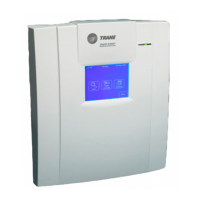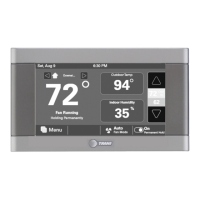Comm5 wiring
BMTX-SVN01C-EN 43
Comm5 wiring
Tracer Summit Comm5 wiring is low voltage Class 2 and must be field-
supplied and installed in compliance with NEC and local codes. For ease
of installation, the recommended wire is low-capacitance, 22-gauge, Level
4, unshielded, twisted-pair. Existing sites that have already been wired
with low-capacitance, 18-gauge, shielded, twisted-pair with stranded,
tinned-copper conductors (Trane-approved, purple-jacketed wire) don’t
have to be rewired; the shielded wire will still work when it is properly
terminated (see Figure 24 on page 47 for an illustration using the purple-
jacketed wire).
Fiber-optic UCM communication is also available where extreme dis-
tance, electrical noise immunity, or building-to-building communication is
required (see “Fiber-optic wiring for Comm5 links” on page 49).
Comm5 configuration requirements
Comm5 wiring must use a daisy-chain configuration (see Figure 18 on
page 37). Maximum wire length for Comm5 is 4,500 ft (1,400 m) with no
more than eight zone sensor communication stubs having a maximum
50 ft length per stub (see “Zone sensor communication stubs on Comm5
links” on page 53).
The configuration length can be extended with the use of a repeater. See
“Comm5 repeater” on page 48 for specifications on the use of a repeater.
See Figure 23 on page 46 for an illustration of a Comm5 wiring configura-
tion with a repeater. The configuration consisting of two daisy chains
linked by the repeater, simulates a branch configuration.
Comm5 wiring, best practices
The following wiring practices are recommended:
• Although Comm5 links are not polarity sensitive, it is good practice to
keep polarity consistent throughout the site.
• Avoid sharing 24 Vac power between UCMs.
• Ensure that 24 Vac power supplies are consistently grounded.
• Avoid overtightening cable ties and other forms of cable wraps. It
could result in damage to the wires inside the cable.
• In an open plenum, avoid running wires across or close to lighting
ballasts, especially those using 277 Vac.
• Do not run communication link wiring in the same conduit or wire
bundle with ac-power wires. Electrical noise may result, which can
make the BCU experience communication link problems.
• Use the same wire type for all Comm5 link wiring, including thermo-
stat zone sensor communication stubs.

